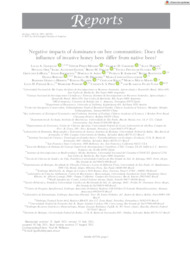Negative impacts of dominance on bee communities: Does the influence of invasive honey bees differ from native bees?
Negative impacts of dominance on bee communities: Does the influence of invasive honey bees differ from native bees?
Author(s): GARIBALDI, L. A; PÉREZ-MÉNDEZ, N.; CORDEIRO, G. D.; HUGHES, A.; ORR, M.; SANTOS, I. A. dos; FREITAS, B. M.; OLIVEIRA, F. F. de; LEBUHN, G.; BARTOMEUS, I.; AIZEN, M. A.; ANDRADE, P. B.; BLOCHTEIN, B.; BOSCOLO, D.; DRUMOND, P. M.; GAGLIANONE, M. C.; HERREN, B. G.; HALINSKI, R.; KRUG, C.; MAUES, M. M.; KIILL, L. H. P.; PINHEIRO, M.; PIRES, C. S. S.; VIANA, B. F.
Summary: Invasive species can reach high abundances and dominate native environments. One of the most impressive examples of ecological invasions is the spread of the African sub-species of the honey bee throughout the Americas, starting from its introduction in a single locality in Brazil. The invasive honey bee is expected to more negatively impact bee community abundance and diversity than native dominant species, but this has not been tested previously. We developed a comprehensive and systematic bee sampling scheme, using a protocol deploying 11,520 pan traps across regions and crops for three years in Brazil. We found that invasive honey bees are now the ingle most dominant bee species. Such dominance has not only negative consequences for abundance and species richness of native bees but also for overall bee abundance (i.e., strong ?numerical? effects of honey bees). Contrary to expectations, honey bees did not have stronger negative impacts than other native bees achieving similar levels of dominance (i.e., lack of negative ?identity? effects of honey bees). These effects were remarkably consistent across crop species, seasons and years, and were independent from land-use effects. Dominance could be a proxy of bee community degradation and more generally of the severity of ecological invasions. Keywords: Apis mellifera, dominance, exotic species, invasion, pollinators.
Publication year: 2021
Types of publication: Journal article
Unit: Embrapa Mid-North
Observation
Some of Embrapa's publications are published as ePub files. To read them, use or download one of the following free software options to your computer or mobile device. Android: Google Play Books; IOS: iBooks; Windows and Linux: Calibre.
Access other publications
Access the Agricultural Research Database (BDPA) to consult Embrapa's full library collection and records.
Visit Embrapa Bookstore to purchase books and other publications sold by Embrapa.

